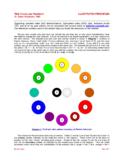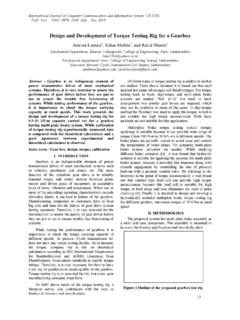Transcription of 1863 Atheoreticalanalysisofbilliardball ...
1 1863A theoretical analysis of billiard balldynamics under cushion impactsS Mathavan , M R Jackson,andR M ParkinMechatronics Research Group, Wolfson School of Mechanical and Manufacturing Engineering, LoughboroughUniversity, Loughborough, UKThe manuscript was received on 9 September 2009 and was accepted after revision for publication on 30 November : :The last two decades have seen a growing interest in research related to have been a number of projects aimed at developing training systems, robots, and com-puter simulations for billiards. Determination of billiard ball trajectories is important for all ofthese systems. The ball s collision with a cushion is often encountered in billiards and it drasti-cally changes the ball trajectory, especially when the ball has spin. This work predicts ball bounceangles and bounce speeds for the ball s collision with a cushion, under the assumption of insignifi-cant cushion deformation. Differential equations are derived for the ball dynamics during theimpact and these equations are solved numerically.
2 The numerical solutions together with pre-vious experimental work by the authors predict that for the ball cushion collision, the values ofthe coefficient of restitution and the sliding coefficient of friction are and , comparison of the numerical and experimental results indicates that the limiting normal velo-city under which the rigid cushion assumption is valid is m/s. A number of plots that showthe rebound characteristics for given ball velocity spin conditions are also provided. The plotsquantify various phenomena that have hitherto only been described in the billiards :impulse with friction, billiards, snooker, pool, ball trajectories, cushion rebound,coefficient of restitution, impact simulations1 INTRODUCTIONS nooker and pool are two popular cue sports generallyknown as billiards (here onwards the term billiards isused to refer to both snooker and pool). Billiards isa classic example of dynamic concepts such as spin-ning, rolling, sliding, and the collisions of was one of the first games to be analysed froma technical perspective.
3 The 1835 study by the Frenchscientist Coriolis, entitledTh orie math matique deseffets du jeu de billard, is a pioneering work on sportsdynamics [1]. Billiards-related research is steadily onthe rise and in recent years a number of robots havebeen developed to play pool and snooker [2 5]. Thereare also a number of initiatives for creating training Correspondingauthor:DepartmentofMechanic alandManufacturing Engineering, Loughborough University, Holy-well Mechatronics Research Centre, Holywell Way, Loughborough,Leicestershire, LE11 3UZ, : for billiard games [6 8]. The research on com-puter billiards, which simulates the real-world billiardsenvironment, also receives the increasing attention ofcomputer scientists seeking to create artificial intel-ligence that can formulate appropriate game-playingstrategies [9 11].Billiards is about manipulating the balls accuratelyon the table along different trajectories. This is per-formed so that all object balls are potted, in thegiven order, and the cue ball is left at an advanta-geous position on the table, after each shot, to playthe next shot successfully.
4 A player often uses cush-ion (or wall/rail/bumper) impacts to achieve plannedtrajectories. Cushion impacts give a great deal of vari-ation to the game. The ball cushion impacts changethe ball trajectories dramatically when combined withthe effects of ball spin and give the player a greaterflexibility in his game strategy (see Fig. 1).Previously, bounces of the ball off the cushion havebeen analysed by incorporating the coefficient of resti-tution between the ball and the cushion as the onlyinfluencing parameter and by considering the ballJMES1964 Proc. IMechE Vol. 224 Part C: J. Mechanical Engineering Science1864S Mathavan, M R Jackson, and R M the cue ball by its bounce off the cush-ion, by imparting different ball spins to it whilestill potting the object ball (shown in black) ball prior to collision with a cushionvelocity normal to the cushion as the sole to current theory, and referring to Fig. 2,once the ball bounces off the cushion, it will havea velocity ofeeV0sin normal to the cushion, and avelocityV0cos along the cushion respectively, whereeeis the coefficient of restitution between the ball andthe cushion.
5 This simple analysis does not consider theeffects of ball spin and the effect of friction during theimpact, since it treats the collision as a purely two-dimensional (2D) phenomenon (the plane of analysisis as given in Fig. 2).Ball spin, both sidespin S0and topspin T0, as shownin Fig. 2, are known to affect both the rebound speedand the rebound angle of the ball. The latter twoquantities are vital in order to estimate the trajectoryof the ball after the cushion collision. Even thoughMarlow [12] tried to address these issues, the waythe analysis was performed involved parameters likethe impact time between the cushion and the ball forwhich the values were unknown. In addition, otherassumptions made by Marlow, such as taking thedirection of sliding between the ball and the cushionduring the time of the impact as constant, do notseem correct (it is shown later that this keeps chang-ing, throughout impact). Most importantly, Marlow sanalysis is not article presents a 3D analysis of the cushion ball impact.
6 For given input conditions (see Fig. 2),the analysis enables the calculation of the reboundconditions. This work will be useful for research onrobotic billiards that involves trajectory calculationsfor the ball motion. Ball trajectory estimation is alsonecessary for the systems that are used to train ama-teur billiard players, as they need to instruct the playerhow a given shot (with a given velocity and spin) willchange the configuration of the balls on the table. Inaddition, a computer simulation of billiards incorpo-rating the knowledge from this 3D impact analysiswould give the user a more realistic experience of thegame. Furthermore, this work will also be of interest tothe researchers working on the physics of billiards (foran exhaustive list of publications on billiard physics,see Alciatore [13]).2 THEORYThe billiards cushion is made of pure gum rubber thathas very good rebound properties. The cross-sectionof a typical billiard cushion is shown in Fig.
7 3. A slopeis usually provided in the cushion such that its contactpoint on the ball is always above the horizontal greatcircle of the ball, in order to prevent the ball from leap-ing up in the air after impact. The following analysisassumes that the cushion does not change its geom-etry during the impact with the ball. This assumptionmay not be valid at high ball speeds, as the normalball velocity at I (see Fig. 3), along the negativeZ -axis,will try to lift up the tip of the cushion. Also, the balland the cushion are assumed to have a point contact,which again may not be true at larger ball speeds, asthe ball will start to sink more into the rubber acting on the ball at the moment of col-lision: a side view along the cushion at tablelevelProc. IMechE Vol. 224 Part C: J. Mechanical Engineering ScienceJMES1964A theoretical analysis of billiard ball dynamics under cushion on the ball during impact (a part of thecushion is shown)According to Fig.
8 3, the height of the contact point atthe rail ( I) ish. In both snooker and poolh=7R/5,whereRis the ball radius. The common normal lineZ ,at the contact point with the cushion, makes an angleof with theY-axis, thus, sin =2 General equations of motionReferring to Fig. 4, for the linear motion of the ballalong theX-,Y-, andZ-directions, the following canbe writtenFIx+FCx=M xG(1a) FIcos FIy sin +FCy=M yG(1b) FIsin +FIy cos +FC Mg=M zG(1c)Within the duration of the collision of the ball withthe cushion, at any time instantt= , consider aninfinitesimally small time period . Now, let Pdenote the impulse or change in momentum due tothe action of a general forceFover . Also, the accu-mulated total impact up to timeTis denoted asP(andassuming that the impact started att=0); hence, itcan be written that P= + Fdt(2a)andP= P= T0 Fdt(2b)The impulse momentum relationship in conjunctionwith equation (2a), along the above directions resultsin the following equations PIx+ PCx=M xG(3a) PIcos PIy sin + PCy=M yG(3b) PIsin + PIy cos + PC=M zG(3c)It should be noted that the impact component due tothe force of gravity acting on the ball,mg, is absentin equation (3c).
9 According to de la Torre Ju rez [14],in the limit t 0, the non-diverging forces, such asthe weightmg, will have a negligible contribution andthus will not influence the increase in momentum. Itshould also be noted that the slope shape of the cush-ion constrains the vertical motion of the ball. Hence, inequation (3c), zG=0. Equation (3c) is rearranged as PC= PIsin PIy cos (3d)Similarly, for the rotational motion of the ball abouttheX-axis, the following equation can be derived, withangular velocity being denoted by ( PIy + PCy)R=I xWhere the moment of inertia of the ballI=2MR2/5,the above equation can be written as PIy + PCy=2MR5 x(4a)Similarly, about theY-axis and theZ-axis PIxsin PCx=2MR5 y(4b) PIxcos =2MR5 z(4c) Impact dynamics at I and CAt the contact point of the ball and the cushion, I, theball will generally slip on the cushion (rolling can betreated as a special case of slipping, where the slip-ping velocity is zero). The slip will take place on theXY plane ( the tangential plane); also noting thatthe axisY is in theYZplane.
10 Let the slip speed of theball at I bes(t)at an angle (t)with theX-axis. Theinstantaneous value of the normal impulsePIaccord-ing to equation (2b) will always be positive, sinceFIis always positive. In addition,PImonotonouslyincreases with timetwithin the interval of ,PIis considered as the independent vari-able for the analysis of impact instead of the regularlyused variable of timet[15]. See Stronge [15] for anelaborative explanation of the other principles usedwithin subsection to Fig. 5, the slipping velocities along theX-axis and theY -axis are given by, respectively xI=s(PI)cos[ (PI)](5a) y I=s(PI)sin[ (PI)](5b)However, y Ican also be written as y I= yIsin + zIcos (6)Using the Amontons Coulomb law of friction, fors>0, also noting that the friction forces/impulsesJMES1964 Proc. IMechE Vol. 224 Part C: J. Mechanical Engineering Science1866S Mathavan, M R Jackson, and R M velocities at I and Care opposite to the direction of sliding, the frictionimpulses alongXandY are PIx= wcos[ (PI)] PI(7a) PIy = wsin[ (PI)] PI(7b)where wis the coefficient of friction between the balland the equations (3a) and (7b), the normal reactionfrom the table surface to the ball is given by PC={sin + wsin[ (PI)]cos } PI(8)Using the earlier argument, for the impact at C, theinstantaneous impulse valuePCshould be chosenas the independent variable.













